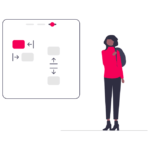Advertising is fundamentally a business based on trust. As a publisher, your job is to build trust between your audience and your content. But you also depend on your advertisers to help build that trust.
Their presence not only impacts your reputation, but also impacts your ability to secure new advertising dollars, generate revenue from your content, and grow your bottom line. So what do you do when you discover invalid traffic on your site?
Definition of Invalid Traffic
Invalid traffic is the artificial inflation of clicks and impressions on a website that does not come from a genuine user with a real interest in the content. Invalid traffic occurs both accidentally and with fraudulent intent. According to Google it can ‘include accidental clicks caused by intrusive ad implementations, fraudulent clicking by competing advertisers, advertising botnets and more.’
Let’s know about the two different types of IVT invalid traffic fraud affecting publishers:
General Invalid Traffic (GIVT)
A less malicious form of IVT ad fraud is caused by online web crawlers, search engine spiders, and ad spy tools. GIVT is usually generated without the publisher’s knowledge.
Sophisticated Invalid Traffic (SIVT)
SIVT fraud uses much more advanced techniques such as proxies, adware, and hijacked devices by malware to mimic real human behaviour and clicks. SIVT traffic can be so sophisticated that even Google is unable to detect 5%-10% of all SIVT traffic. Incentivized clicks and PPC click exchange programs can also be classified in this category of IVT, however, these methods are very quick to be detected by AdSense and AdMob quality control algorithms.
Follow these Steps to Eliminate Common Causes of IVT Invalid Traffic
Source Identification
If you’re detecting non-human traffic to your pages then it has to be coming from somewhere. Determining the geographical point of origin is the first step toward solving the problem. You can use IAS reports, seen below, for a regional breakdown of invalid traffic. If your site traditionally serves specific countries or regions, using this report to identify outlier traffic sources can help to detect potentially invalid traffic sources.
Geography isn’t the only way to spot traffic outliers.
Most publishers have a fairly consistent, and unique mix of traffic sources and no one knows better than you which devices and channels (mobile web, desktop, in-app, etc.) are your strongest. Using IAS reports to look for outlier channels can further help to narrow down where fraud is originating from and help to identify the source.
Traffic Reviewing
If you’re using paid traffic sources then the possibility of fraudulent or bot-based traffic can be higher. Conduct a thorough review of your traffic-sourcing methods and traffic suppliers. Discount traffic suppliers often rely on bots or click farms to generate views and impressions. Insist on extra transparency where necessary to ensure that any traffic you pay for is authentic. If a supplier’s offer seems too good to be true, then it probably is.
Data Center Traffic
There are variations of invalid traffic that are not always the result of fraud, meaning no deceptive activity is involved. Even though data centre traffic can be the result of legitimate business activities, it can still sometimes appear as non-human traffic and may confuse advertising partners looking for authentic audiences.
If you’ve detected large amounts of data centre traffic you should first confirm that you aren’t running any software tools that would require data centre traffic to hit your site. Running traffic-driving tools can produce invalid traffic that advertisers find undesirable. You may also want to be aware of any cybersecurity, testing or analytics tools you might be using that could cause data centre traffic to hit your site and therefore trigger IAS invalid traffic detection models.
The steps described above are useful for understanding what causes invalid traffic. If you’ve run through all three of these steps without detecting any anomalies, then it’s possible that your site has been targeted by genuine fraudsters without your knowledge. Bots are often instructed to visit premium sites to pick up desirable cookies which can then be used to monetize fraudulent sites. If you’re operating a premium site then this may explain some low-level invalid traffic.
If you’ve detected invalid traffic on your site, then it’s possible your advertising partners have too. Being proactive and well-informed can go a long way toward ensuring that you and your advertisers present a united front against fraud.
How to Find and Eliminate Invalid Traffic (IVT) On Your Website?
To begin to identify and eliminate invalid traffic, publishers should start by filtering out bots. This can be done with the use of Google Analytics. Login to your Google Analytics account, go to the Admin button, Navigate to the View tab and click on View Settings. Simply, scroll down the page and select the Bot Filtering option if it’s unchecked. Finally, ensure to Save your settings.
With advertisers becoming increasingly concerned about ad fraud, publishers should ensure that they are on top of the threat posed by invalid traffic.
For maximum ad revenue for everyone involved, publishers should constantly be monitoring their traffic sources and using the above methods to filter IVT.
Is your site struggling with invalid traffic, bots, and ad fraud? Contact our team at AdPushup to learn more about protecting your ad reputation and revenue today.

Shubham is a digital marketer with rich experience working in the advertisement technology industry. He has vast experience in the programmatic industry, driving business strategy and scaling functions including but not limited to growth and marketing, Operations, process optimization, and Sales.







